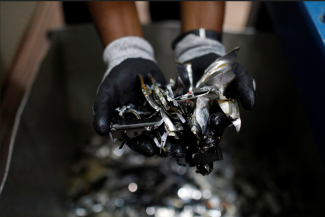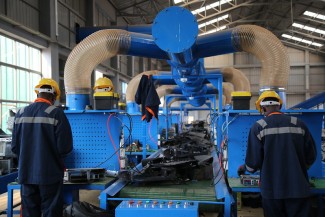|
|
|
Some of the world’s poorest countries are also some of the richest – in biological diversity. Many least developed countries (LDCs) in both Asia and Africa, including Madagascar, Lao PDR and the Democratic Republic of the Congo, are the custodians of the world’s biodiversity and guardians of species of wild fauna and flora that are or could become threatened with extinction unless trade in them is regulated and monitored.
As LDCs look for ways to achieve the goal of increasing their share in world trade, diversifying their export base, generating sustainable livelihoods and securing sources of income for rural communities, while at the same time conserving species and ecosystems, they should keep the Convention on International Trade in Endangered Species of Wild Fauna and Flora (CITES) in mind.
International rules governing commercial trade in wildlife species
CITES is a legally binding treaty among 182 states and the EU that has regulated trade in species of wild animals and plants since 1975. The objective of CITES is to ensure that such trade is:
* sustainable – not detrimental to the survival of the species in the wild;
* legal – the specimens have been obtained in accordance with national laws and regulations; and
* traceable – that a product can be traced back to the origins in the wild no matter how much it has been transformed subsequently.
Almost all LDCs are parties to CITES and can trade in accordance with the provisions and conditions set forth in the Convention and in the Resolutions adopted by the Conference of the Parties.
Commercial trade under CITES can be authorised in specimens of species included in Appendices II and III, which includes about 97% of the 36,000 species for which trade is regulated by CITES under certain conditions. (Appendix I lists species that are the most endangered among CITES-listed animals and plants – i.e. threatened with extinction – and for which commercial trade is prohibited.)
The specimen, defined as the entire plant or animal (live or dead) or parts or derivatives thereof, including finished products, of a species included in Appendix II can be exported if the competent national management authority has issued an export permit. The management authority must have proof that the specimen in question was legally acquired and the national CITES scientific authority must confirm that the trade will not be detrimental to the survival of the species in the wild.
The relationship between CITES and World Trade Organization (WTO) agreements has been harmonious and based on mutual supportiveness, transparency and trust.
All parties have designated their competent management and scientific authorities. Non-parties wishing to trade in specimens of CITES-listed species must designate competent authorities to issue comparable documentation.
Trade in specimens of CITES-listed species is subject to the Convention and requires a CITES document irrespectively of whether the specimens have been taken from the wild or produced in captivity or under controlled conditions.
The relationship between CITES and WTO agreements
As explained in the publication CITES and the WTO – Enhancing Cooperation for Sustainable Development, the relationship between CITES and World Trade Organization (WTO) agreements has been harmonious and based on mutual supportiveness, transparency and trust.
To date, there has been no WTO dispute directly challenging a CITES trade measure. On the contrary, in the “US–Shrimp” dispute, the Appellate Body found that the measures adopted by the US to protect marine turtles from being harmed and killed during shrimp fishing operations were justified under GATT Article XX on exceptions from rules.
The Appellate Body also found that such measures could be applied to marine turtles living beyond the territorial borders of the United States and further that the term “exhaustible natural resource” under Article XX (g) would include also living species which may be subject to depletion or extinction.
Wildlife trade for the sustainable development of local communities
CITES is placed squarely at the intersection between development, environment and trade; and if well managed has the potential to contribute to all three.
For example, if local communities receive an economic benefit from trade in the regulated wildlife products (species), these communities will have an incentive to take better care of biological resources, which in turn will contribute to their conservation. This theory of change sounds simple and straightforward but it is based on some critical assumptions combining aid for trade and conservation approaches.
Exploring these underlying assumptions may be useful to understand how a value chain in specimens of CITES-listed species may contribute to the conservation of the species.
In the above example of local communities in poor countries, they include at least the following.
* There is a market for the species’ products and the enabling conditions for tapping into this market are in place (access to finance, access to market, infrastructure, etc.).
* Increased trade will lead to benefits to local communities and stakeholders. This requires stakeholders to be organised to receive and distribute the benefits among them.
* The benefits realised must lead to positive changes in attitudes and behaviours by local stakeholders. Stakeholders need to be fully aware of the link between the realised benefit and the expected behaviour change, otherwise there is no guarantee that this link will materialise.
* The changed behaviour must lead to a reduction of the threat on the species, which in turn should allow the population of the species to recover and stay healthy.
Challenges to the sustainable use of listed species
CITES work on livelihoods has focused mainly on demonstrating how local and rural communities and indigenous people may use CITES-listed species sustainably for their livelihood.
The Handbook on CITES and Livelihoods, Part II contains a number of case studies related to different species, economic sectors and countries. Examples range from trophy hunting and the collection of seahorses to export of the skins of crocodilian produced in captivity in Cambodia and export of agarwood extracts from Lao PDR.
Since the Handbook was published more case studies have been prepared, including one on the trade in bark from the tree prunus Africana – also known as red stinkwood or African cherry – that is used in the medicinal industry.
CITES is placed squarely at the intersection between development, environment and trade; and if well managed has the potential to contribute to all three.
This tree is included in Appendix II of CITES and is native to Cameroon, the Democratic Republic of Congo, Kenya, Madagascar, Tanzania and Uganda, all of which are participating in the export. In Uganda, over 5,000 farmers are involved in the harvesting of the bark of the trees that are owned by local communities. The communities harvest and sell the bark to a registered Ugandan company that pays the farmers and processes, transports and exports the bark. The company also provides seedlings for reforestation by local communities.
The utilisation of prunus Africana has generated financial and social benefits. A total of 1.5 tonnes of prunus bark has been sustainably and legally exported between 2006 and 2017, increasing from 10,800 kg in 2006 to over 250,000 kg in 2016. This has translated into an income of almost US$800,000 directly to farmers of prunus Africana. The generation of an economic benefit from the conservation of the species contributes to ensuring its conservation and long-term commercial use.
Some of the key challenges highlighted in these case studies include:
* strengthening partnerships between government, national and local authorities;
* securing the engagement and commitment of private sector investors and donors;
* lack of sustainable management and risks of over-exploitation;
* weak governance and risks of corruption around permits and other licenses;
* limited organisation of local communities in producer associations;
* inadequate distribution of benefits among local stakeholders; and
* continued illegal trade in CITES-listed species.
The Handbook contains a series of steps for governments to take in order to overcome the challenges and successfully and sustainably use CITES-listed species for conservation. The CITES Secretariat has also produced two short films showcasing how working with communities on developing a well-managed value chain involving CITES-listed species can contribute to improving their conservation status.
Implications for aid for trade
In the context of aid for trade, it should be recognised that trade in specimens of CITES-listed species can be critically important for the people living with wildlife and can contribute to the conservation of the species. The economic benefits of such trade may not fully monetise the conservation impact and therefore risk under-evaluating the positive impact of trade that is sustainable, legal and traceable.
-------
Sofie H. Flensborg is legal officer with the CITES Secretariat.
Header image - ©EIF
If you would like to reuse any material published here, please let us know by sending an email to EIF Communications: eifcommunications@wto.org.



